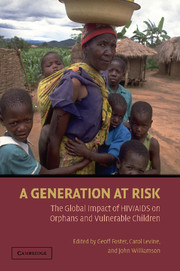Book contents
- Frontmatter
- Contents
- Foreword
- Preface
- Contributors
- Introduction: HIV/AIDS and Its Long-Term Impact on Children
- 1 Family and Community-Based Care for Children Affected by HIV/AIDS: Strengthening the Front Line Response
- 2 Strengthening Households and Communities: The Key to Reducing the Economic Impacts of HIV/AIDS on Children and Families
- 3 The Response of the Educational System to the Needs of Orphans and Children Affected by HIV/AIDS
- 4 Psychosocial Impact of the HIV/AIDS Epidemic on Children and Youth
- 5 Human Rights and Children Affected by HIV/AIDS
- 6 Religion and Responses to Orphans in Africa
- 7 Making the Right Choices in the Asia-Pacific Region: Protecting Children and Young People from HIV and Its Impacts
- 8 Troubled Tapestries: Children, Families, and the HIV/AIDS Epidemic in the United States
- 9 Interventions to Support Children Affected by HIV/AIDS: Priority Areas for Future Research
- 10 Finding a Way Forward: Reducing the Impacts of HIV/AIDS on Vulnerable Children and Families
- Chronology of Important Events
- Resource Guide
- Index
- References
9 - Interventions to Support Children Affected by HIV/AIDS: Priority Areas for Future Research
Published online by Cambridge University Press: 05 June 2012
- Frontmatter
- Contents
- Foreword
- Preface
- Contributors
- Introduction: HIV/AIDS and Its Long-Term Impact on Children
- 1 Family and Community-Based Care for Children Affected by HIV/AIDS: Strengthening the Front Line Response
- 2 Strengthening Households and Communities: The Key to Reducing the Economic Impacts of HIV/AIDS on Children and Families
- 3 The Response of the Educational System to the Needs of Orphans and Children Affected by HIV/AIDS
- 4 Psychosocial Impact of the HIV/AIDS Epidemic on Children and Youth
- 5 Human Rights and Children Affected by HIV/AIDS
- 6 Religion and Responses to Orphans in Africa
- 7 Making the Right Choices in the Asia-Pacific Region: Protecting Children and Young People from HIV and Its Impacts
- 8 Troubled Tapestries: Children, Families, and the HIV/AIDS Epidemic in the United States
- 9 Interventions to Support Children Affected by HIV/AIDS: Priority Areas for Future Research
- 10 Finding a Way Forward: Reducing the Impacts of HIV/AIDS on Vulnerable Children and Families
- Chronology of Important Events
- Resource Guide
- Index
- References
Summary
In a field of study and practice as diverse and dynamic as HIV/AIDS care and impact mitigation, it is imperative to continuously reappraise both the evolving situation and the assumptions underlying current actions. The priority remains the implementing of effective and scaled-up responses to the pandemic. To keep asking the right questions, researchers and practitioners must understand the range of operational possibilities. The impetus for reappraisal comes from many sources: situation and needs analyses on the ground, empirical field and clinical research, changes in nongovernmental organization (NGO) and government priorities, scenario planning, and the availability of resources that can be directed toward further research.
Most crucially, political pressure is now increasingly being exerted on governments to fulfill obligations outlined in the United Nations (2001) Declaration of Commitment on HIV/AIDS, an outcome of the United Nations General Assembly Special Session on AIDS (UNGASS). Rather than research for its own sake, studies must be linked to the development of operational assistance to guide and scale up action. At the same time, inaction due to lack of knowledge is itself not acceptable. Governments and other key stakeholders must “act on data which is already available…. It is not necessary to wait for data before starting work” (Loudon 2003).
The immediate information needs are overwhelmingly practical and geared toward practitioners and policymakers. More difficult to ascertain, but still vitally important, are the theoretical bases for both the research and the reconsideration of research directions.
- Type
- Chapter
- Information
- A Generation at RiskThe Global Impact of HIV/AIDS on Orphans and Vulnerable Children, pp. 232 - 253Publisher: Cambridge University PressPrint publication year: 2005
References
- 2
- Cited by



